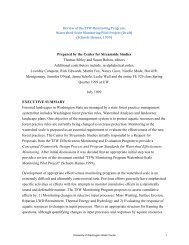Copyright 2012 Aileen M. Echiverri-Cohen - University of Washington
Copyright 2012 Aileen M. Echiverri-Cohen - University of Washington
Copyright 2012 Aileen M. Echiverri-Cohen - University of Washington
Create successful ePaper yourself
Turn your PDF publications into a flip-book with our unique Google optimized e-Paper software.
cingulate gyrus and left frontal lobe activity coincided with decrements in PTSD symptoms from<br />
pre to post-treatment. Thus, evidence from three preliminary studies, albeit inconsistent, suggests<br />
that psychotherapy may improve inhibitory functioning in PTSD.<br />
Taken together, both SER and PE are effective treatments for chronic PTSD (Foa et al.,<br />
1999; Brady et al., 2000) and both are thought to potentially affect the fear circuitry involved in<br />
inhibitory learning (Felmingham et al., 2007; Rauch et al., 1998). Despite this, and with no trial<br />
to date directly comparing these two treatments, one treatment may be more superior in leading<br />
to greater changes in inhibitory processes. A comparison <strong>of</strong> pre- to post-treatment effect sizes<br />
showed PE typically produced larger effects (e.g., Foa et al., 2005) than SER (e.g., Brady et al.,<br />
2000; Friedman, Davidson, & Stein, 2009). Further, the Institute <strong>of</strong> Medicine (2007) report also<br />
concluded that while there were enough efficacy studies in support <strong>of</strong> exposure therapy as a<br />
treatment for PTSD, there were not for SSRIs. Thus, individuals with PTSD treated with PE<br />
were expected to produce more sustained and stronger changes in inhibition than with SER.<br />
Further, if inhibitory processes are a critical mechanism in PTSD treatment, regardless <strong>of</strong><br />
treatment modality, individuals with PTSD should show concomitant improvement in inhibition<br />
and PTSD symptoms following treatment. Indeed, both psychotherapy (e.g., Felmingham et al.,<br />
2007) and pharmacotherapy (Rauch et al., 1998; Sachinvala et al., 2000; Seedat et al., 2004) for<br />
PTSD are thought to strengthen the inhibitory control <strong>of</strong> the mPFC over a hyperactive amygdala,<br />
resulting in a reduction <strong>of</strong> PTSD symptoms as well as improvement in overall functioning (e.g.,<br />
Bryant et al, 2005; Ohtani & Matsuo, 2006). Therefore, PE and SER may ultimately work<br />
towards the same goal <strong>of</strong> restoring the functional integrity <strong>of</strong> the brain structures implicated in<br />
inhibition, which may be sufficient to bring about overall symptom reduction in PTSD.<br />
15
















